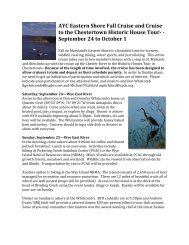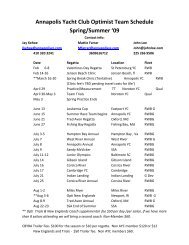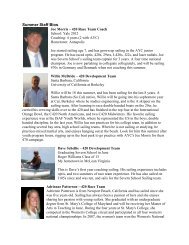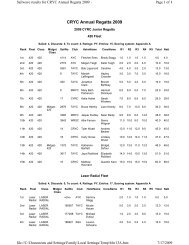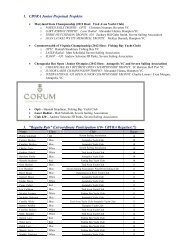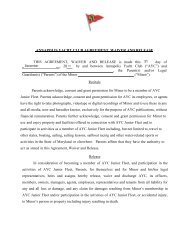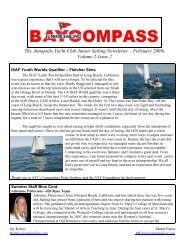You also want an ePaper? Increase the reach of your titles
YUMPU automatically turns print PDFs into web optimized ePapers that Google loves.
Tenacious racing in the AYC <strong>Fall</strong> Series two months after the Fastnet storm.<br />
west out the Solent, along the south coast of England,<br />
past Lands' End, across the Irish Sea to Fastnet Rock,<br />
about 8 miles south of Cork, Ireland, passing south of<br />
the Scilly Islands and finishing in Plymouth. As we<br />
approached the rock, the wind was blowing about 25<br />
knots. Our spinnaker was up. This was in the days before<br />
race trackers, so we guessed that we were in good shape<br />
against our competitors. And, there were a lot of good<br />
ones. Peter Blake was racing Condor, Dennis Conner<br />
was racing Williwaw, and Steve Colgate had his boat,<br />
Sleuth, there. In fact, 303 boats started the race.<br />
The weather forecast was late as we approached<br />
Fastnet Rock. When the broadcast finally came over the<br />
VHS radio Peter Bowker wrote down every word. His<br />
report to the crew on deck was ominous. “The winds are<br />
forecasted to build to Force 8 or 9, and possibly up to<br />
Force 10!” Ted's comment was frightening, “Oh my God,<br />
20 people are going to die tonight!” We had just finished<br />
a roast dinner cooked by Jane Potts. We rounded the<br />
Rock and hoisted a No. 2 headsail. At 2000 hours I was<br />
on deck as watch captain. At 51 degrees North, the sky<br />
was still light. The wind built and I called for a change to<br />
the No. 3. One hour later we changed down to the No. 4<br />
working jib. At one point, Ted yelled from below for me<br />
to take my hat off so I could feel the wind better. It was<br />
blowing over 40 knots! I could feel the wind through my<br />
foul weather gear. After dark, Courtney Jenkins used a<br />
flashlight to read the compass. The waves were gigantic.<br />
I had never seen anything like this. I wondered how I<br />
would describe the race when I returned to <strong>Annapolis</strong>.<br />
By Midnight the wind was howling. Ted took<br />
over the wheel. I had steered four hours straight. About<br />
an hour later, Ted called for the mainsail to come all<br />
the way down. The crew was heroic wrestling the heavy<br />
Dacron sail below decks. The wind was well over 50<br />
and still building. The waves were 35 feet tall. All of<br />
us were seasick. Tenacious was a sturdy 61-foot boat<br />
designed by Olin Stephens, who also designed the 12<br />
meter Courageous. We had great faith in Olin and his<br />
engineering.<br />
At 0400 it was my time to go back on deck. I spent<br />
four more hours steering. We only had the No. 4 headsail<br />
set. I would see a green light on the bow and then a red<br />
light. It was tough changing course. When dawn started<br />
to brighten the sky, we set the storm trysail. That made<br />
steering easier. By 0600 the wind was back down to 50<br />
knots and shifting to the west. Tenacious was now reaching.<br />
When we crossed the finish line later that night, the wind<br />
was down to 15 knots. On shore, it was bedlam.<br />
Little did we know that CBS news anchor,<br />
Walter Cronkite, had reported Tenacious as “missing.”<br />
There were hundreds of news reporters on the docks. We<br />
VOLUME 3, NO. 2<br />
AYC BEACON<br />
11



